|
|
 |
PCKent 2 : Description
Part 1 - Decision Support
|
Introduction
PCKent 2 is made up of sophisticated functions, dedicated to the repertorial work, and to data editing.
The interface is easy to use, and intuitive. It is divided into many modules, each of them being specialized in a particular task.
Here is the description of the modules that are involved in the case analysis:
|
 |
THE REPERTORY
The repertory used in PCKent comes from the 6th edition of the Kent's repertory.
It has been corrected and slightly enriched by Dr. Edouard Broussalian, a renowned French homeopath.
You can browse the repertory content, using many display options.
For example, you can choose the visibility level of rubrics and remedies. You can decide to display the French translation, the cross references, the opposite links, the authors' references. Rubrics can be displayed in single or
multi-line mode, on 1 to 6 columns...
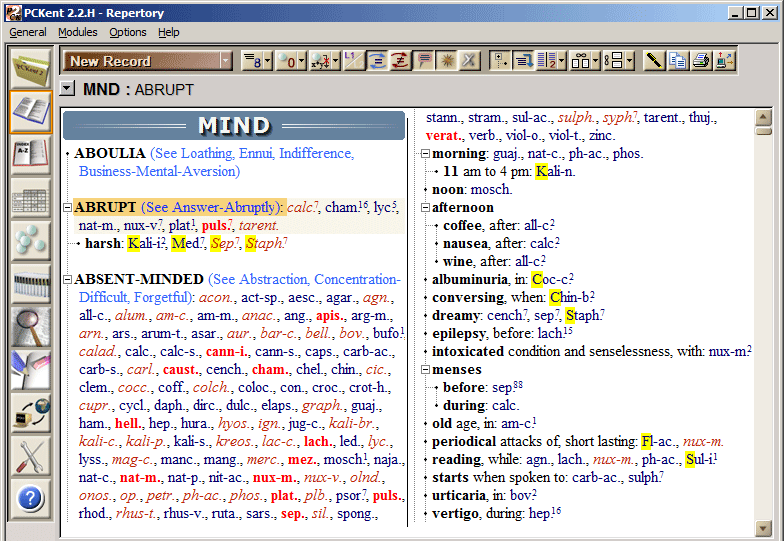
THE GENERAL INDEXThe
General Index allows to find all the rubrics containing
the keywords you specify. It is intelligent, fast, and
very easy to use. Just type
cough loose and you'll get the few dozen of
rubrics containing these words.
The General Index knows the meaning of each word. Thus, you can
make researches whatever the conjugated forms, the abbreviations,
the gender or the number used. And you can
extend the research to synonymous, close
sense words, broad sense words...
That way, the experienced practitioner can instantly find a
rubric that he knows to exist, with few well chosen
keywords.
And the neophyte, despite his limited knowledge of the
repertory's vocabulary and organization, keep every chance
of finding a precise symptom, thanks to the automatic
relational mechanisms used during such a process.
For example, the advanced user will type
rumbling eating after to get on the
ABDOMEN: Rumbling / eating /
after rubric, while the apprentice will use
grumbling after
eating to achieve the same result.
The General Index can even handle homographs (words with more
than one meaning, such as will
that can express the futur of the verb
"to be", or that can mean "conscious choice
of action").
Once you gain more experience with it, you will
appreciate the ability to guide the research of rubrics by
using some filters (for example, you can search for rubrics
containing the word anxiety,
and having at least one remedy from the
ranunculaceae family)...
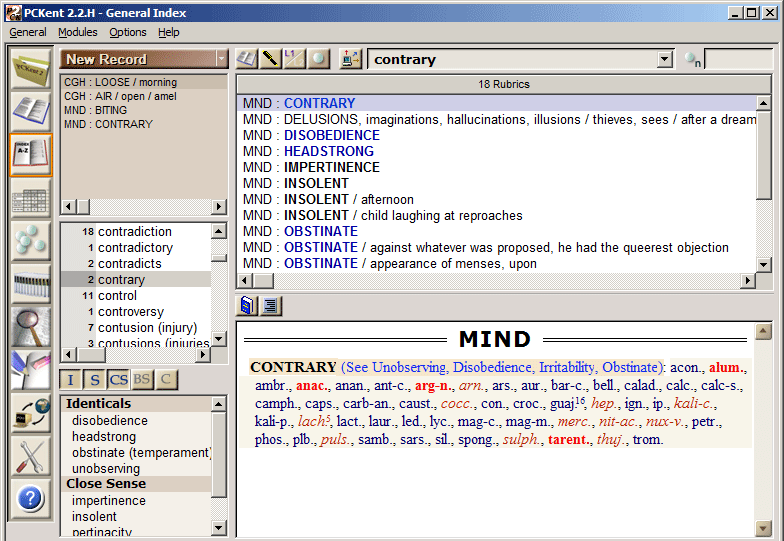
In the results frame, the words displayed in bold and bright blue are closely related to the keywords you typed.
And they become darker if they are distancing from the original meaning.
You can even enrich PCKent's dictionnary by adding some new word, then linking them to the existing ones...
THE REPERTORIZATION GRIDThe repertorization grid is a fundamental module dedicated to the research of the simillimum.
It allows you to:
- classify remedies according to various algorithms,
- generalize the rubrics that appear to limit the repertorization,
- establish a differential diagnosis between remedies that well cover the case,
- display a range of additional information, according to your needs.
Each rubric of the repertory is characterized by a general value. Thus, general modalities are more valorised than sensations, themselves more than a simple objective sign... This rubric valorization allows to find the remedies
that best cover the important signs. But, according to the clinical context, you can modify those default values; or you can force one or more signs to become essential. (For example, this could be useful in the case of an ordinary
loose cough that resists to a well targeted antibiotic therapy).
The relative valorization concept, that brings out the affinity of a remedy for a particular modality, is also integrated into the calculation...
Many options allow to change the remedies classification process by favoring the occurrences, the sum of remedies' grades...
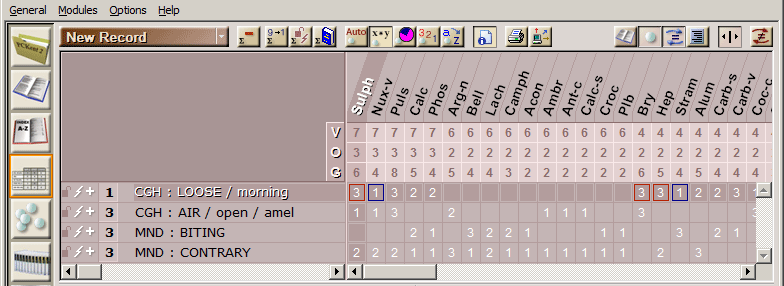
The relative valorizations are highlighted
with red or blue rectangles.
That way, on the above screenshot, you notice immediately that Sulph and Nux-v are
rather specific of the loose cough in the morning.
The generalization process: it will be useful
whenever one or several interesting remedies do not cover some
significant symptoms. In such a situation, if the involved symptoms are
linked to rubrics of closely smimilar meaning (cross references), you
can activate the most appropriate ones. That way, remedies are given an
extra chance to provide a better coverage of the case, and you are sure
that you cannot forget a remedy because of shade of meaning.
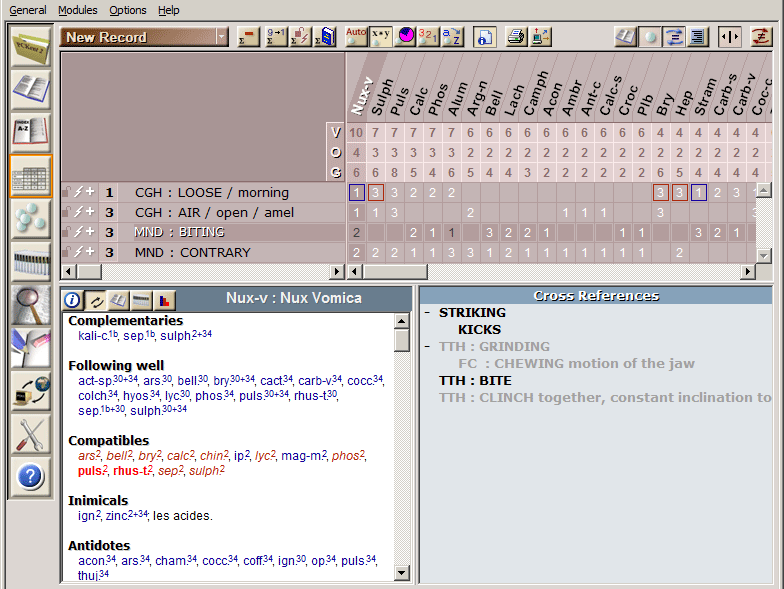
The "MND :
BITING" rubric is linked to:
"STRIKING", "TTH:GRINDING", "TTH: BITE", "TTH:
CLINCH together".
In turn, the
"STRIKING" rubric is linked to "KICKS"...
On the above screenshot, the "STRIKING", "KICKS"
and "TTH: BITE" rubrics have been activated.
That way, the Nux-v. column shows a grade 2 displayed in
black to indicate that it is absent from the original rubric
(MND: BITING),
but present in one of its active cross references.
The differential diagnosis: it intervenes when it
is necessary to make a choice between several remedies. Its operation is
based on the exploitation of links that connect opposite rubrics. For
example Sympathetic is
opposed to Cruelty,
Selfishness,
Unsympathetic,
Unfeeling, and
Joy at the misfortune of others.
With this information, PCKent can establish a true differential
diagnosis.
Just select the remedies among which you hesitate, and PCKent will find
the relevant questions to ask to your patient.
That way you will easily discover that Aesc.
is tranquil, irritable the evening, and weak during stool; while
Nux-v. is restlessness,
nervousness, anxious, irritable the morning and weak after the stool…
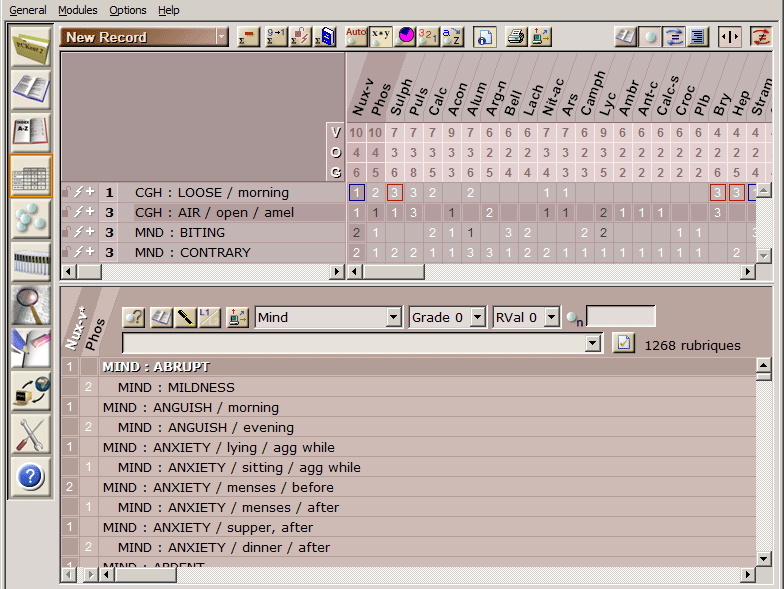
THE REMEDIES
MODULEThis module
brings together all the remedies related informations: the
main properties, the relations with other remedies (complementaries,
following well, compatibles, inimicals, antidotes ...), the
list of the repertory's rubrics where the remedy is present, the digital
books in which it is described...
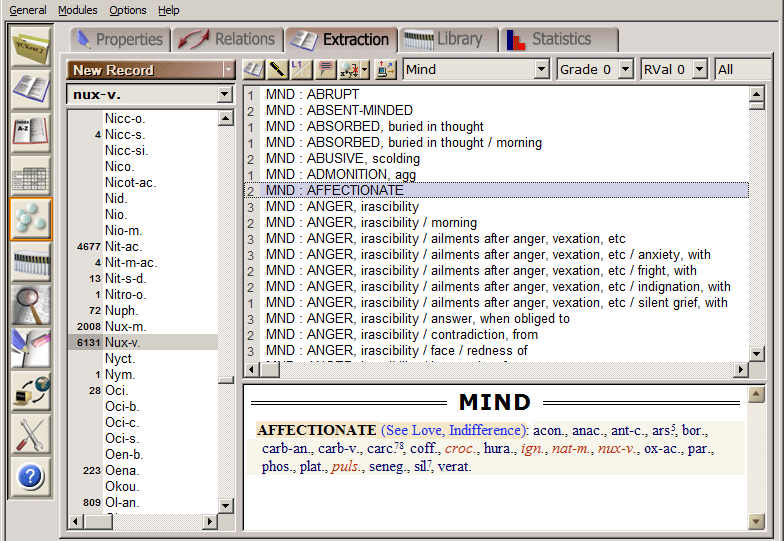
THE PATIENTS RECORDS
This module is not intended to replace a medical practice
management software.
Nevertheless it contains the required functions to manage
the patients records and their consultations, while
memorizing the repertorizing works.
One of its purposes is to gather information that will be
subject to sophisticated queries (for example: search for
all female cases of Silicea for which nail biting has been
improved).
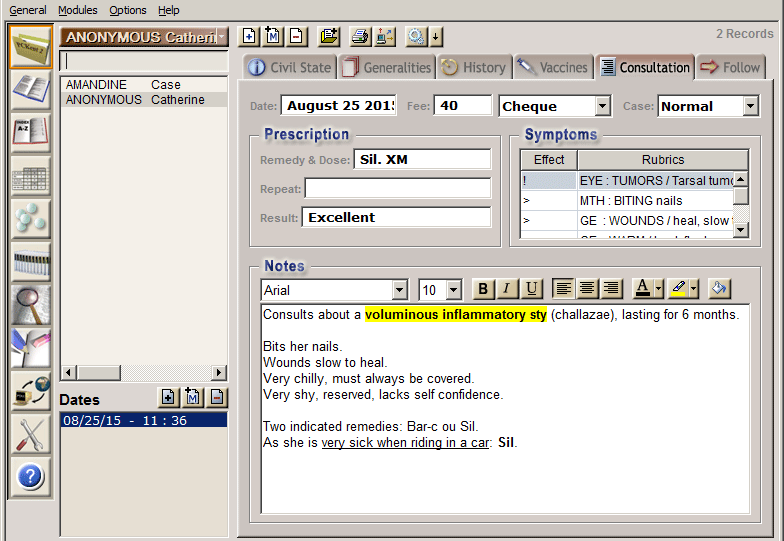
|